
Tools for a
digital detox
Take a break from tech

Tools for a digital detox
Take a break from tech
Your device comes with features to help you find a balance with technology.
Our smartphones are an important part of our everyday life, but sometimes they can become a source of distraction—who hasn’t lost track of time mindlessly scrolling through social media feeds?
Ironically, our smartphones might be able to help us find a better balance with technology. Here are Android and iOS tools that encourage us to take breaks and set boundaries with technology.
What you can do with these tools
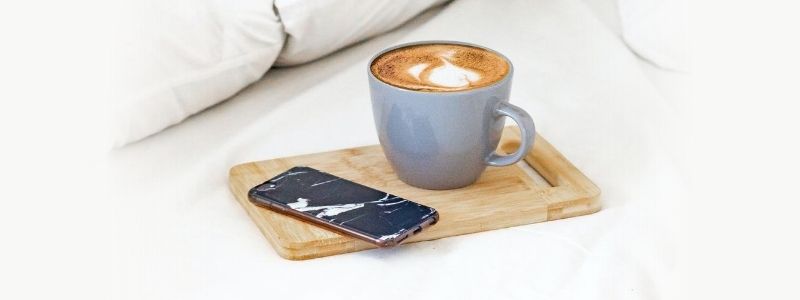
Both Android and iOS come with features to help you:
- Understand how you’re using your device by giving you a breakdown of how much time you’re spending in apps.
- Create boundaries and better manage your screen time and app usage with app timers.
- Carve out quiet time by scheduling notification-free periods.
You can access these features in:
- iOS via Settings > Screen Time. Screen Time is available from iOS 12 and up.
- Android via Settings > Digital Wellbeing. If your Android device does not come with the Digital Wellbeing feature, you can get it on Google Play.
Read on for more details on how to use Digital Wellbeing and Screen Time.
1. Understand how you use your device

Android Digital Wellbeing
Go to Settings > Digital Wellbeing. From there, you’ll get an overview of the day’s total screen time and apps used. At a glance, you’ll also see the number of times you unlocked your phone and how many notifications you received.
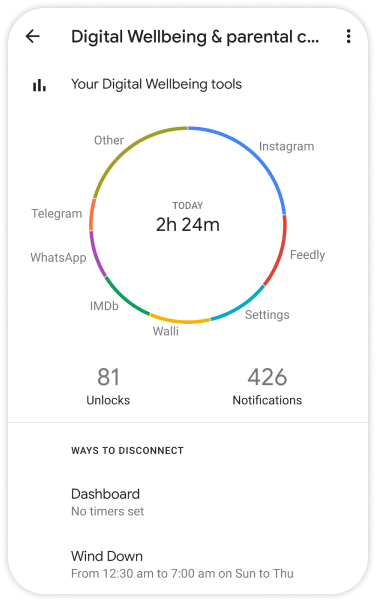
Tap into any of the apps in the pie chart to view daily and hourly breakdowns of:
- How much time you spent in the app
- How many app notifications you received
- How many times you launched the app
To see detailed breakdowns for other apps (i.e. the apps you did not use that day), tap Dashboard and scroll through your list of apps and tap on a specific one.
iOS Screen Time
Access the tool via Settings > Screen Time, tap Turn on Screen Time and follow the onscreen prompts to set it up. From there, you’ll get an overview of your screen time—tap on the time total for a more detailed breakdown.
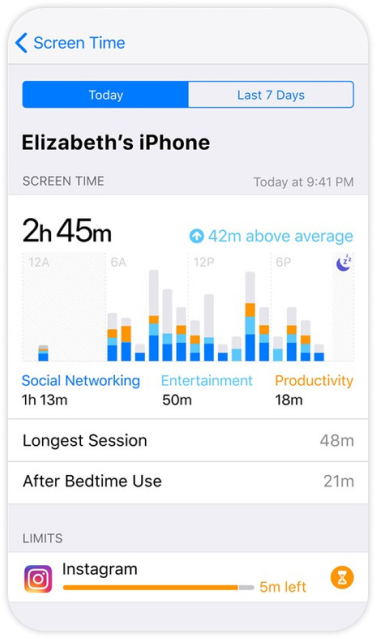
Tap Today for a daily report and Last 7 Days for a weekly report. These reports show you:
- How much time you spent in each app
- How much time you spent across each app category (e.g. Social Networking or Productivity)
- How many app notifications you received
- How often you use your device
2. Cut down screen time by setting usage limits

You might have gleaned some surprising insights about how you use your phone from the dashboard. For example, you might be spending more time than you’d like on Facebook.
The good news is, both tools let you restrict the number of hours you spend on an app daily. Once you hit that limit, you can no longer launch the app until midnight, when the timer resets.
Android: Set an App Timer
From Dashboard
- Go to Settings > Digital Wellbeing > Dashboard.
- Scroll through the list of apps until you see the app you wish to restrict.
- Tap the hourglass icon on the right of the app name.
- Set an app usage limit using the time duration picker.
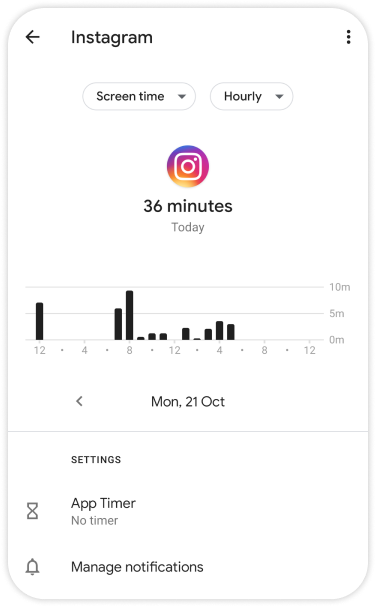
From the usage chart
- Go to Settings > Digital Wellbeing. You will see the circular chart showing which apps you’ve used that day.
- Tap the app you wish to restrict, then App Timer.
- Set an app usage limit using the time duration picker.
You can delete or reset your app timers any time you wish.
iOS: Set an App Limit
From App Limits
- Go to Settings > Screen Time > App Limits. You will see a list of app categories.
- Select the category of apps you wish to limit.
- Set a limit using the time duration picker, tap Add, and you’re done.
- This will limit all the apps grouped under that category.
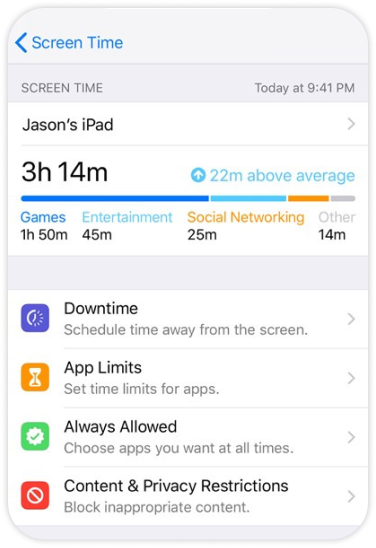
Exclude apps from App Limits
- Go to Settings > Screen Time > Always Allowed to select apps you wish to exclude.
- The app limit applied to the category will not apply to those specific apps.
From Screen Time report
- Go to Settings > Screen Time.
- Tap on the time total or the chart to enter the detailed breakdown. You will see the list of apps you’ve used today and during the week.
- Tap the name of the app you wish to restrict, then tap Add Limit.
- Set a limit using the time duration picker.
- You can also customise limits by days of the week by tapping Customise Days. For example, you may want to limit Facebook only on weekdays during work hours.
- Tap Add, and you’re all set.
3. Schedule distraction-free quiet time
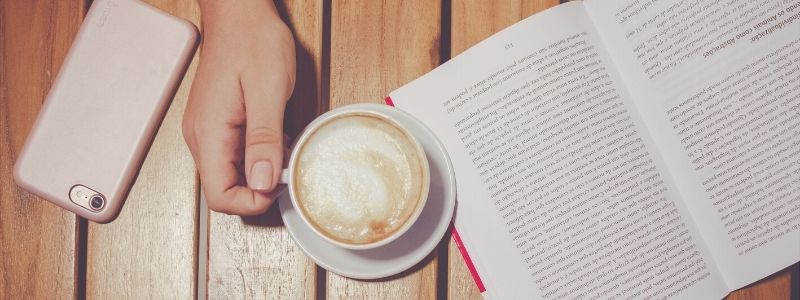
Calls, text messages, and app notifications also play a big part in distracting us. Escape the constant pinging for our attention by scheduling some quiet time on your phone.
In Android, Digital Wellbeing comes with the option to schedule when Do Not Disturb mode is turned on and off. In iOS, you can schedule some Downtime.
These scheduled quiet times are handy if you need to focus during work hours, wish your family dinners to be a distraction- and device-free affair, or want to mentally prepare for bed by setting your device aside.
Android: Schedule Do Not Disturb
What is Do Not Disturb
When Do Not Disturb is on, sound and vibration will be muted for a scheduled period of time or until you choose to turn it off.
You can set some exceptions: for instance, you can mute all calls except those from starred contacts.
It’s a useful tool to help you minimise distractions, but make sure not to mute anything important, like your morning alarms or urgent calls from mum.

How to set up a Schedule
- Go to Settings > Digital Wellbeing.
- Scroll down and tap Do Not Disturb > Schedules.
- Select one of the default schedules (e.g. Sleeping) or tap on the gear icon on the right of the schedule to edit it to suit your needs.
- You can also create a schedule from scratch based on time, calendar events, or driving mode.
- A filled checkbox to the left of the schedule means it is in use.
How to set up exceptions
Go to Settings > Digital Wellbeing, then scroll down and tap on Do Not Disturb. From there, you can set exceptions to the rules:
- Tap Calls to fine-tune which calls are allowed. For example, you can allow calls from starred contacts to get through when the mode is turned on.
- Tap SMS, MMS and messaging apps to fine-tune which messages are allowed.
- Tap See all exceptions to select which sounds and notifications are allowed when Do Not Disturb is on. For example, select Allow alarms if you use your phone as an alarm clock.
iOS: Schedule Downtime
What is Downtime
When Downtime is turned on, only phone calls and allowed apps will be available. Apps that you have not allowed will be dimmed on your homescreen.
You will be blocked from using them during Downtime, and you will not receive any notifications from them.
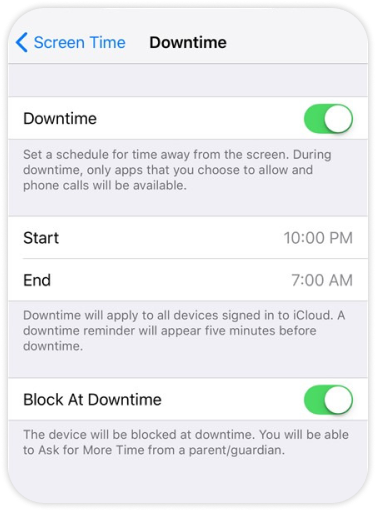
How to schedule Downtime and allow apps
- Go to Settings > Screen Time > Downtime.
- Tap the switch to turn on Downtime.
- Choose a start and end time with the time picker, then tap Screen Time when done.
- Tap Always Allowed to select which apps to whitelist during Downtime.
- Tap the + icon on the left of an app to allow it.
- Tap back, and you’re done.
How to set up exceptions
Go to Settings > Digital Wellbeing, then scroll down and tap on Do Not Disturb. From there, you can set exceptions to the rules:
- Tap Calls to fine-tune which calls are allowed. For example, you can allow calls from starred contacts to get through when the mode is turned on.
- Tap SMS, MMS and messaging apps to fine-tune which messages are allowed.
- Tap See all exceptions to select which sounds and notifications are allowed when Do Not Disturb is on. For example, select Allow alarms if you use your phone as an alarm clock.


